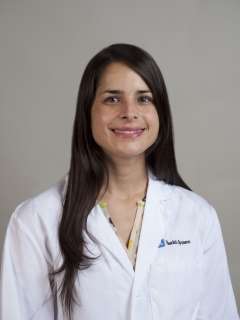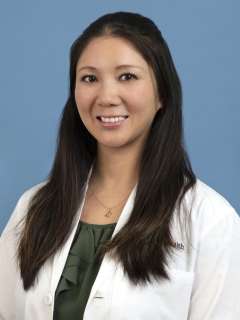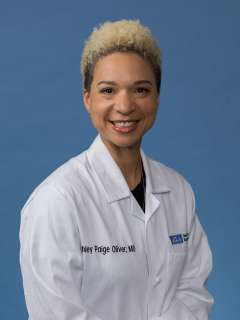Which Fellowship is Right for Me? Part 2
October 26, 2023 | Emma Huebner, MD, Zarah Antongiorgi, MD, Sandra Sacks, MD, K. Elliott Higgins III, MD, Ashley Oliver, MD
This is the second article of a two-part series on different fellowship training options after residency. In the last issue of The DAPM Handoff, we highlighted subspecialists from pediatric anesthesiology, obstetric anesthesiology, and liver transplant anesthesiology. In this issue, we are focusing on critical care medicine, palliative medicine, regional anesthesiology, and cardiothoracic anesthesiology. To our new interns, CA-1s, and CA-2s, I hope you enjoy these stories and possibly glean some insight into what drives you, and where you want to take your own career after residency.

Zarah Antongiorgi, MD
Critical Care Medicine
Medical School: UCSF
Residency: UCLA
Fellowship: UCLA
Did you start residency knowing that you wanted to do your fellowship of choice?
Not at all. I had always loved critical care, especially after completing a sub-internship as a medical student at UCSF in the SICU at San Francisco General Hospital, but I did not start residency planning to do any fellowship. I was waiting to see what I liked. The anesthesia-led ICU experience was limited during my UCLA residency—really only VA SICU and PICU were the spaces in which anesthesia intensivists were working. By the end of residency, I just wanted to work and see my family. But after 18 months of doing exclusively OR anesthesia, I realized that I wanted more. I sought career advice from the UCLA anesthesia chair at the time, and she relayed that an ICU fellowship was starting in our department. A few months later, I became the first anesthesia critical care fellow at UCLA and never looked back.
What was your favorite rotation during residency? Your least favorite?
My favorite rotation during residency was being the Team Captain. I loved being part of all the action, running around all over the hospital, triaging cases, and being involved in team-based care. At that time, the term “perioperative physician” wasn’t widely used, but that is what I enjoyed. I liked possessing a set of skills that could be applied in multiple scenarios, often in high acuity situations, across the hospital.
My least favorite rotation was probably Medicine wards at CHS during internship! It was a brutal workload, and I capped my patient load every 24-hour Q3 call. At that time, we had to participate in complete post-call rounds after a 24-hour call shift, so I was in the hospital for 30 hours straight multiple times a week. One highlight—I did meet one of my best friends during that month, and we still hang out today.
What personality traits or skill sets are beneficial for your subspecialty in anesthesiology?
Critical care requires diligence, patience, focus, diplomacy, and empathy. You are pulled in many directions at once, constantly triaging. You need to be able to maintain your calm, find the path forward, and lead your team in the right direction, all while being kind to yourself and others in those stressful moments, or else you will burn out. You also need to stay curious and open to the unknown, as every patient and colleague can teach you something new.
What is your favorite thing about your subspecialty?
I love being part of a multidisciplinary team caring for critically ill patients. I am surrounded by such brilliant and hard-working colleagues, including physicians from multiple disciplines, nurses, respiratory therapists, nutritionists, physical therapists, speech therapists, social workers, and many more who all contribute to accomplishing amazing things for critically ill patients. I also find the deep connections I make with patients and their families so incredibly rewarding.
What does a typical day look like for you when you are practicing within your subspecialty?
I wake up early before the sun comes up, review all of my patients’ charts before I arrive at the hospital, and receive sign out from the overnight ICU attending. I touch base with my team—which can include residents, a nurse practitioner, a fellow, and a medical student—and make sure we are on the same page about immediate care needs for our patients before we formally round. During formal rounds, I lead the team in identifying the major issues and defining the official plans for the day. After rounds, we take care of urgent patient care needs, be it procedures or discussions with colleagues or families about goals and plans of care. I try to teach on rounds or find time after patient care work to do formal teaching.
New admissions roll in any time, from the OR or floor or ER, sometimes in the middle of rounds. I’m checking in and following up on patients all day. A patient can decompensate at any time. Some days, I spend hours at a patient’s side, supporting their failing organs with a myriad of interventions while trying to fix the underlying cause. I never know exactly how the day will unfold, and I love that about SICU. Every day is a little different. When 5pm rolls around, I sign out to the night team, focusing on major patient issues and the plan of care. They take over for the night until I return in the AM.
What are the biggest challenges that you face within your subspecialty?
Critical care is mentally, emotionally, and physically demanding work and can lead many to burnout. The pandemic exposed this reality to the rest of the world in a way people outside the ICU realm had not fully appreciated. The degree of human suffering we are often confronted with can be overwhelming, and the amount of work, combined with the high stakes involved with caring for such critically ill people, can weigh heavily on providers. We need to create health care systems that provide work environments that better support critical care physicians, allow them enough time to recover after a stretch of ICU time, and gives them enough resources to do their best work.
Are there any changes you foresee within the field of anesthesiology that will affect your subspecialty?
I do worry that less people will go into critical care when there is such high demand and high-paying jobs for general OR anesthesiologists across the country. I literally get text messages every day with job offers to practice anesthesia across the nation.
If you hadn’t done what you are currently doing, what would have been Plan B?
Really hard question! I truly love my job and can’t imagine doing any other type of work. I guess if pushed to answer, I probably would have been some kind of teacher, probably in a science-related field.

K. Elliott Higgins III, MD
Regional Anesthesia and Acute Pain Management (RAAPM)
Medical School: University of Connecticut
Residency: UCSF
Fellowship: Dartmouth-Hitchcock Medical Center
Did you start residency knowing that you wanted to do your fellowship of choice?
Not at all! I started residency training suspecting that I would do a fellowship, but I was not at all sure which one. In fact, throughout residency and leading up to the point of fellowship applications, I had a very difficult time choosing a fellowship... I waffled between cardiac, OB, trauma, liver, and regional. I even prepared applications for cardiac and regional, truth be told. I really enjoyed so many aspects of my training, and the thought of developing further focused expertise in several areas sounded great. Ultimately, though, regional and acute pain won me over, and I'm so thrilled with my choice.
What was your favorite rotation during residency? Your least favorite?
Favorite: Advanced Regional Anesthesiology (which was a focused regional rotation in a very busy outpatient orthopedic surgical center) tied with my CA-3 trauma rotations (2 weeks of nights in a TC-like role at a very busy level 1 trauma center in San Francisco)
Least favorite: Preop Clinic (sorry PEPC! I love all you all though!)
What personality traits or skill sets are beneficial for your subspecialty in anesthesiology?
At this point, at least in the RAAPM positions I've held at a couple of institutions, it's clear to me that the technical skills of a true regionalist (needle skills-meet-advanced-anatomical-knowledge) are outweighed by the nontechnical skills required to be a stellar regional/acute pain attending. The crucial skills to me are: communication, communication, communication, a collaborative mindset, situational awareness, adaptability, communication, and communication. I think it's also very helpful to be a reasonable conversationalist (did I mention communication?).
Humor and kindness go a long way for me when performing a brachial plexus block on a very anxious patient. It's also crucial to be humble: sometimes blocks are very, very challenging. Sometimes for safety, a block is the best plan for a patient. But sometimes, for safety, it is not the best plan for a patient. Finding a way to remove ego is helpful for a lot of clinical medicine, and I think regional anesthesia is included in that. Lastly, in regional anesthesia, we have to know how to go fast and slow. Regional requires efficiency, and we have to hustle at times (aspects I adore). But sometimes, we need to be slow with purpose and with nuance. Being able to pivot between different modes of operation is, in my opinion, crucial to regional anesthesia—which I suppose is a form of adaptability.
What is your favorite thing about your subspecialty?
The team approach required for success is, hands down, my favorite part of regional anesthesia and acute pain medicine.
What does a typical day look like for you when you are practicing within your subspecialty?
It can be quite variable, but my regional anesthesia days typically earn me around 20,000 steps per my Apple Watch. Lots of blocks, frequent risk/benefit analyses, episodic focused teaching, constant communication, continual coordination across multiple teams, lots of huddles with my core regional team, and roughly 100+ text messages/pages coordinating care.
What are the biggest challenges that you face within your subspecialty?
Regional anesthesia can be technically quite challenging, and managing relationships with many stakeholders requires a lot of energy. Those are perks, but they also can be very challenging. Also, regional anesthesia is not without risk. Minimizing the risk of peripheral nerve injury, wrong-sided block, local anesthetic toxicity, and more requires constant vigilance, and this can also be truly challenging on busy days.
Are there any changes you foresee within the field of anesthesiology that will affect your subspecialty?
I adore how RAAPM is ever-changing and requires constant upkeep as a practitioner. I don't see that changing, and so I see change as a constant! To me, the goal of RAAPM is, ultimately, to prevent the development of chronic pain safely, while optimizing acute postoperative analgesia with optimal procedural safety profiles. To do this with nuance is to stay at the cutting edge of our understanding of acute pain management, and it is a very exciting field to be in.

Sandra Sacks, MD
Pain Medicine and Hospice/Palliative Medicine
Medical School: Boston University
Residency: Stanford University
Fellowships: Pain Medicine, UCLA; Hospice and Palliative Medicine, Cedars-Sinai Medical Center
Did you start residency knowing that you wanted to do your fellowship of choice?
Not at all! I loved being in the OR and never would have thought that I would have a complete outpatient practice, doing cancer pain of all things. I thought I wanted to do peds anesthesia when I first started. Now, my patient population is mostly geriatric!
What was your favorite rotation during residency? Your least favorite?
I was one of those residents who loved every rotation, and I considered a fellowship in each one of them (even if it was only for a day or two). But if I had to narrow it down, I loved ICU the most. That was where I was introduced to the subspecialty of Palliative Medicine!
What personality traits or skill sets are beneficial for your sub-specialty in anesthesiology?
Compassion. Empathy. Active listening. As a palliative care provider, my job is to advocate for my patients. I try to remember the platinum rule to "treat others how THEY want to be treated." (Rather than the golden rule we are all familiar with: "treat others how you would want to be treated.")
As physicians, we are taught in our training to prioritize life and health. However, this may not always be the case for our patients, especially those with advanced serious and life-limiting illnesses. I try to take myself out of the equation and really listen to them. This way, I can propose medical treatment plans that best align with their own goals and values.
What is your favorite thing about your subspecialty?
This one is easy—hands down, my patients. There is something so incredibly humbling about being able to be a part of this cancer journey with them. I loved being in the OR, but I missed the longitudinal relationships with patients and their families. I also love the community and relationships I have built with my colleagues in hematology/oncology, radiation oncology, surgical oncology, and interventional radiology.
What does a typical day look like for you when you are practicing within your subspecialty?
During a typical day, I see patients in clinic. Ideally, we try to set up my patients’ clinic visits so that they align with their treatment infusions or oncologist appointments. I review their symptoms, explore which procedure/injection might be helpful, and possibly refill their medications. Sometimes, if their disease has progressed through another line of treatment or if they are too ill to receive another round of treatment, I help mediate family meetings. These meetings can often be difficult, with a lot of emotions present. Oncologists may present other options or clinical trials, and sometimes, we may discuss transitioning to hospice care.
What are the biggest challenges that you face within your subspecialty?
In my field, unfortunately, it's losing patients. While there are many success stories, especially now with newer targeted cancer therapy, many of my patients still die. Making condolence calls and writing condolence cards never seems to get any easier.
Are there any changes you foresee within the field of anesthesiology that will affect your subspecialty?
With the increase in elderly and frail patients needing surgery and procedural interventions requiring anesthesia, I am hoping that perioperative Palliative Care will be integrated into a multidisciplinary algorithm for managing high-risk elderly patients in the future.
If you hadn’t done what you are currently doing, what would have been Plan B?
If I didn't have this amazing opportunity to practice palliative care and cancer pain management, I would probably be doing a combination of OR anesthesia and inpatient palliative care consults. Given my background in palliative medicine, I would be very interested in helping with pre-op evaluations in our growing geriatric and frail patient population. I could see myself collaborating with primary care providers and surgeons to develop some way to hold challenging goals-of-care discussions more upstream with our most vulnerable patients before they present to the OR.

Ashley Oliver, MD
Medical school: Columbia University
Residency: UCSF
Fellowship: UCLA
Did you start residency knowing that you wanted to do your fellowship of choice?
No, I started residency with the intent of pursuing dual fellowships in critical care anesthesia and palliative care medicine. Halfway through CA-1 year, it became clear to me that I sought expertise in acuity and the management of hemodynamic instability in the operating room (vs. in the ICU or more broadly in the hospital), and this is when I entertained the notion of cardiac anesthesia or liver transplant fellowships.
What was your favorite rotation during residency? Your least favorite?
My three favorite rotations in no particular order were (1) as a senior resident at San Francisco General Hospital, San Francisco’s Level One trauma center, (2) pediatric anesthesia at Mission Bay Hospital in San Francisco, and (3) the cardiac anesthesia rotation at Kaiser San Francisco.
The rotations that were most challenging for me were chronic pain, because I prefer hospital-based medicine over delivering care in the clinic setting. Another challenge was the OB anesthesia service at Mission Bay. I actually adored providing labor analgesia to mothers and helping babies be born safely. However, I recall a couple of extremely challenging 24-hour calls with a lot of acuity. I felt that responsibility very deeply as a mother of two young children.
What personality traits or skill sets are beneficial for your subspecialty in anesthesiology?
I would say some protective character traits of mine are that I don’t take a lot of things personally. As a pacifist, I am often able to help smooth things over, prioritize what is important (typically patient safety and good communication for a productive learning environment), and I work well in a fast-paced environment in which circumstances are dynamic and change from moment to moment.
What is your favorite thing about your subspecialty?
We perform incredibly complex procedures for patients who are high-risk, and we get to tell patients that our number one job is to help keep them safe. That provides me with a profound and enduring sense of purpose. I am grateful for the opportunity to care for every patient I have encountered during fellowship and now as an attending.
What does a typical day look like for you when you are practicing within your subspecialty?
It depends on my assignment for the day, and there can be considerable variability. In the cardiac ORs, I am paired 1:1 with a CA-2 or CA-3 resident, and I may have a fellow as well. On these days, I arrive by 7:00am to ensure that the resident feels comfortable and confident in the set-up and does not have any last-minute questions. I go introduce myself to the patient to see if there are any lingering questions from them or their family members. We are in the room by 7:30, and we place invasive lines and intubate by 8:30. I supervise the transesophageal echocardiogram (TEE) of the fellow, or perform it myself if there’s no fellow on that day, and confirm diagnosis and any other pertinent findings that could challenge the operative or cannulation plan, such as severe aortic insufficiency, or a persistent left superior vena cava. I share these findings with the cardiothoracic surgical attending, and then the patient is prepped and draped.
Until the patient is safely cannulated and on bypass, I am carefully watching how they are handling the anesthetized state, and titrating inotropes and vasopressors accordingly. Once on bypass, I always take time to see any cardiac pathology in vivo that I noted on the TEE, like severe calcification of the mitral valve, or a bicuspid aortic valve. Coming off bypass is a highly dynamic time, and I work with the surgeon, perfusionist, and the anesthesia resident and fellow to optimize the patient to resume native control of cardiac output. We perform a post-TEE exam, and then help ensure hemodynamic stability during chest closure and transport to the ICU. My day usually ends after ICU sign-out around 4 or 5pm.
I also have days where I work in the cath lab, either solo or with trainees. Occasionally, I can be found in the main OR, and about once a week, I serve on the perioperative echocardiography service, which performs TEEs in the cath labs, procedure rooms, PTU, and ICU.
What are the biggest challenges that you face within your subspecialty?
I would say that a personal challenge is related to the fact that I am still in the early stage of my career. A tremendous amount of skill is built up over time and is directly related to experience. I like to say, you may have good instincts and be well trained, but something we often admire in seasoned anesthesiologists is their experience. And this takes time to develop; there are no shortcuts. Practicing at UCLA is an incredible opportunity, since I have the great fortune to be able to solicit the advice of seasoned, experienced anesthesiologists in the group. My advice to those who are seeking their first jobs after training is: make sure you find a place where you feel you can ask questions, seek advice and counsel, and where you feel your journey to attaining greater experience will be supported.
Are there any changes you foresee within the field of anesthesiology that will affect your subspecialty?
I think we will always need anesthesiologists trained in cardiac surgery: this has seemed fairly consistent since the 1970s when the subspecialty was starting to be carved out of general anesthesia. Cardiac surgery is changing, but there will continue to be surgical interventions along with minimally invasive and catheter-based procedures. I think we have a great opportunity to participate in research in the field, particularly with regard to echocardiography and the patient with cardiac disease. I also foresee opportunities to participate in—and even lead—research related to health disparities in the cardiac surgical population.
If you hadn’t done what you are currently doing, what would have been Plan B?
That’s a story for a whole ‘nother time! I would either be a professor in Cinema and Media Studies at The University of Chicago, or I would be working on a farm and family-owned vineyard in Sicily. Happy to share those stories with anyone who is interested.